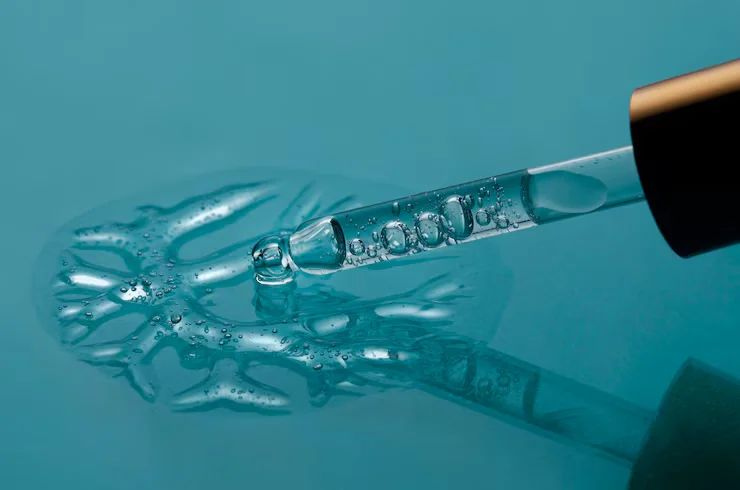What if the secret to healthier skin and faster healing was already inside your body? GHK-Cu, a naturally occurring copper peptide, has caught the attention of both dermatologists and biohackers for its role in regeneration and repair.
Discovered decades ago but only recently thrust into the spotlight, this molecule is now being explored for everything from anti-aging skincare to tissue recovery. Let’s break down what GHK-Cu is, how it works, why experts are excited about it, and what you should know before trying it yourself.
What Is GHK-Cu?
GHK-Cu is a copper peptide, short for glycyl-L-histidyl-L-lysine bound with a copper ion. It occurs naturally in the human body and plays a role in tissue remodeling, inflammation control, and wound healing.
First isolated in human plasma, it has since been found in saliva and urine as well. Researchers discovered it in the 1970s while studying how older livers regenerate poorly compared to younger ones, leading to the identification of this small but powerful molecule.
In the body, GHK-Cu acts like a signaling molecule, sending messages to cells that stimulate repair processes. It helps activate genes associated with regeneration and suppresses those related to inflammation and tissue breakdown. Its ability to bind copper — a trace element vital for many biological functions — gives it unique bioactivity that has drawn increasing attention in both science and wellness communities.
Why Biohackers Are Hooked on It
Biohackers are constantly looking for compounds that optimize health, extend longevity, and improve cellular performance — and GHK-Cu checks several of those boxes. It’s often included in self-experimentation routines focused on skin repair, faster recovery, and even nootropic effects, with some users claiming better cognitive clarity and improved sleep. These anecdotal benefits, while not all fully backed by clinical trials, fuel continued curiosity.
Part of the appeal lies in GHK-Cu’s natural origin and regenerative potential. Unlike synthetic drugs that force change, peptides like GHK-Cu aim to mimic or enhance the body’s own systems. This aligns with the biohacking ethos of working with biology rather than against it. From forums to wellness podcasts, it’s regularly discussed as a cutting-edge ingredient for people serious about aging well and staying resilient.
Why Dermatologists Are Excited
In dermatology, GHK-Cu is gaining traction for its ability to boost skin regeneration and collagen production. It has shown promise in reducing fine lines, improving elasticity, and evening out skin tone — all without the irritation often seen with ingredients like retinoids. Its anti-inflammatory effects also make it a candidate for helping calm conditions like rosacea or redness-prone skin.
What sets it apart is its dual action – repairing existing skin damage while stimulating new, healthy growth. Dermatologists are especially interested in how it may accelerate healing after treatments like microneedling or laser resurfacing. Compared to many popular skincare actives, GHK-Cu offers a gentler yet scientifically supported approach that’s becoming more common in professional-grade skincare formulations.
What the Science Actually Says
Scientific studies on GHK-Cu show a range of promising effects, particularly in wound healing and anti-inflammatory action. In lab and animal studies, it has been shown to increase blood vessel growth, improve skin tensile strength, and activate genes linked to tissue repair.
One study even found that it could suppress over 70% of inflammatory genes while boosting those associated with regeneration, which supports many of the anecdotal claims made by users. Resources like Exploring Peptides offer detailed breakdowns of these findings, making complex research more accessible to the public.
However, it’s important to separate emerging research from confirmed clinical outcomes. While early studies are encouraging, more large-scale human trials are needed to verify long-term benefits and ideal usage.
The scientific community generally agrees that GHK-Cu is safe and biologically active, but there’s still much to learn about how best to use it and who benefits the most. This cautious optimism is why both researchers and practitioners continue to explore its full potential.
How People Are Using It
Most commonly, GHK-Cu is applied topically in the form of creams or serums, allowing it to work directly on the skin’s surface. Users often report improvements in skin texture, hydration, and healing after cosmetic procedures.
Some people combine it with microneedling to enhance absorption and target deeper layers of the skin, though this should ideally be done with professional guidance to avoid irritation or contamination.
More advanced users — particularly those in medical or supervised settings — may explore injectable or oral forms of the peptide. These methods aim to deliver systemic benefits, such as supporting muscle repair or overall inflammation control, but they also carry higher risks and stricter regulations. Regardless of method, consistent use over time appears to yield better outcomes than short-term or one-off applications.
Should You Try It?
GHK-Cu may be worth considering if you’re looking for a gentler alternative to harsher skincare ingredients or want to support recovery after procedures. It’s especially popular among people managing signs of aging, scarring, or inflammation. However, as with any supplement or topical treatment, it’s important to manage expectations — results can vary based on skin type, formulation quality, and consistency of use.
People with certain health conditions, such as copper metabolism disorders, or those who are pregnant or nursing, should consult a healthcare provider before trying it. Not all products are created equal, so it’s wise to look for well-reviewed options with transparent ingredient lists and third-party testing when possible. While the science is still evolving, early evidence and user feedback suggest that GHK-Cu is more than just hype — but it’s not a miracle cure either.
Conclusion
What makes a single molecule stand out in both medical journals and online wellness forums? GHK-Cu has earned attention from dermatologists and biohackers alike because of its unique ability to promote regeneration, reduce inflammation, and support skin health at the cellular level.
While research is still ongoing, early studies and real-world use suggest it holds significant potential when used correctly. As with any health-related decision, it’s essential to weigh the evidence, understand your own needs, and approach new treatments with informed caution.







